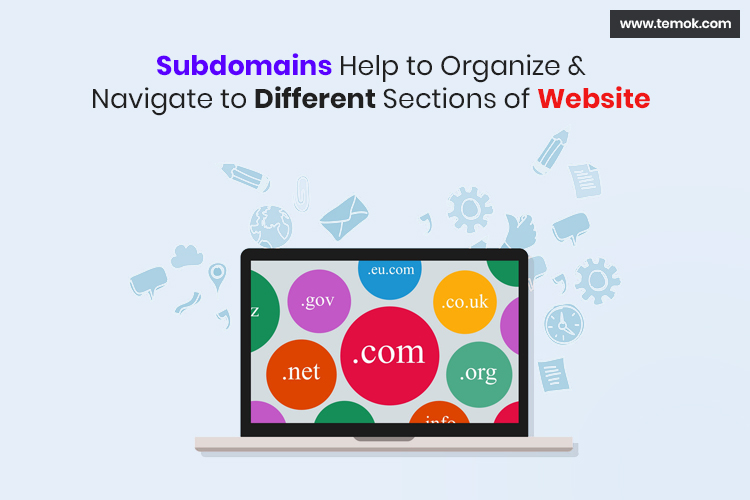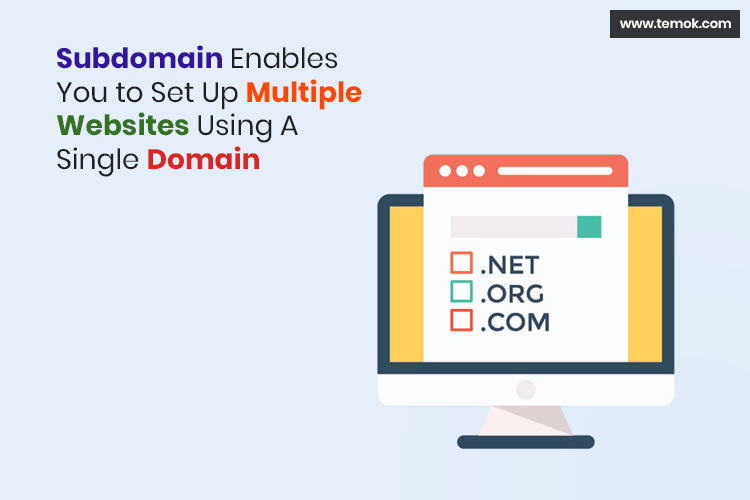While searching for a perfect domain name for your website, you may come across the term “subdomain” many times. For the new startups, the subdomain may be a bit confusing to understand. This article is the ultimate source to know what is a subdomain, its functions, and how to create one. If you are making your website and unsure whether to use a sub-domain, then you probably find your answers in this article.
If you are a business owner or startup with no subdomain, you might need one after knowing about its different functions and uses for your website. Read this article from start to end to get an idea about what is a subdomain and why you should get one for your site.
Table of Contents
What is a Subdomain?

As we know the domains are arranged into a simple hierarchy or tree structure known as a domain name system (DNS). The DNS begins with top-level domains (TLD) such as.org or.com that are organized into subdomains and domains. For instance, abc.com is a domain and blog.abc.com is a subdomain. Subdomains help to organize and navigate to different sections of the website.
A sub-domain is a completely distinct part of your website that functions under the main domain. You can think of your sub-domain as an additional aspect to your primary domain name. Using a sub-domain rather than a domain allows you to create a completely distinct portion of the website without the disturbance of having to arrange a new website or manage other domain redirections.
For instance, if you are developing a huge resource directory that will be filled with useful tutorials, user assistance, and all types of other bonuses. There are chances that its structure and layout will be different as compared with the main website.
The subdomains can be used for developing a separate company blog or e-commerce page. You notice that many online businesses and startups are using the subdomains for this purpose. Now, with the subdomain, you can use only one main domain and use it for making a website for different users and niches. Creating the sub-domain on your website is very easy. The details about creating and setting up the sub-domain on your website are given below.
How to Create a Subdomain?

Anybody can easily create a subdomain through a domain registrar or WordPress hosting account. There are many online hosting service providers available in the market that you can use to create a sub-domain for your website. Here, I am showing you the steps that you need to follow to create your sub-domain through your account through a web hosting company or cPanel.
Steps to Create a Subdomain
To make a subdomain using a WordPress hosting account, you should first log into the web host account. Open your account, and click on the “Domains” tab on the left. You will see a submenu that will open with numerous choices. Now, on the list, click on the “Subdomains” tab.
On the right, there is a field comprising your domain name. If you have only one domain on a web hosting account, you don’t need to change anything. In case you have more than one domain on your account, it will be registered in the drop-down menu. For example, you have one domain name on your account, “yourdomain.org”.
After that type your new subdomain name in the field on the right. You can name your subdomains like gallery, blog, store, or anything for which you are going to make your subdomain. For example, you have named your new sub-domain “demo”.
When you have typed the name for your sub-domain, now click the “Create” button.
Immediately, you can see your subdomain at the bottom of the screen. In front of a domain name, the address of your subdomain will now appear. In this example, the newly made subdomain will look like “demo.yourdomain.com”. You may notice that the new sub-domain automatically fills in the home folder field for the subdomain.
Congratulation! Your subdomain is created.
This is all you need to do for creating a sub-domain using your Webhosting account.
Uses and Functions of Subdomain

There are many companies using subdomains because of their enormous uses and benefits for online businesses. Here are some of the major uses of subdomains that you should consider using for your website.
Create a Different site
One of the best things about using the subdomain is that it allows you to make multiple websites using the same domain. This is particularly correct if you are targeting different audiences and customers for your product and services to different regions and the language and content of your website requirements to be personalized for every region. It is an effective and easy method as far as the performance and cost a concerned, to make entirely different websites rather than maintaining one substantial multi-lingual website.
But overall, you might want to move your blog because it serves a different purpose than your main domain. Depending on what your main domain does, it might make sense to move your blog to a subdomain so they can exist separately, while still being tied together under your main domain. Subdomain enables you to set up multiple websites using a single domain.
Many websites now have separate web subdomains for different regions. Apart from the customizing of the content, the companies also use the subdomain to separately optimize their websites for customers in all regions. For instance, whenever a user opens their website, they are redirected to the website subdomain specifically created for their region.
Subdomain for Specific Users
Many businesses cater to more than one customer segment then subdomain is the best option to make specific pages for every category of customers. For example, if a restaurant opens its outlet to a new place, then you can add the new location of the restaurant to the main website, and make a new site page for this new location. By doing this, the new location of the restaurant has its own online identity and it is still under the main website.
Sometimes you need your website to be appealing to different kinds of users. For example, businesses with many international audiences need to translate their website into different languages. In this case, the better option is to create your website’ subdomains so all users can see a more relevant and understandable version of your website. It is cost-effective and easier to make separate pages rather than having one multilingual website. From time to time, you might need to target a different audience from your web content. Using the subdomains, your websites are optimized for every region separately, but all of them are hosted on one single master domain.
Testing Out New Website
It is very common to use subdomains as a testing tool while creating or updating a new website’s version. On your subdomain, you can also install a program such as WordPress and use it as a distinct entity from the main site. You can use it to test your plugins and updates on a subdomain to understand and monitor their performance before you publish them on your site.
When you use the subdomains as a testing tool, the subdomain will be something that web users would not think of typing, as you don’t want the users to see the content. The subdomains can also be used as “hidden” pages that you can use safely to test the new functions and features of your site before it is officially live.

Separate Mobile Site
The subdomain is also an effective tool to offer a more mobile-friendly experience for your website audiences. Rather than working on a responsive website with fundamentals that function on all sizes of the screen, you can go for an adaptive method that signifies an exclusive experience for each size of the screen. As a substitute, content scaling to a suitable size, your website can control the kind of device and serve a specific layout to that scope. A subdomain can be used to provide a more mobile-friendly experience on the website.
For instance, the visitors who access you from the desktop see the URL of your website. me, on the other side, the tablet, and mobile audiences will see the URL m.yourwebsite.me, hosted on a subdomain.
Search engines such as Google can identify the device type that a web user is using, to make your online experience more compatible with your device. For example, if you are using a mobile device Google will provide you with the mobile version of the website to improve their user experience. You can make distinct website versions for mobile devices, and even more explicitly for every size of the screen.
This adaptive method provides a unique and more effective experience to the users, specifically catered to the device type they are using currently. These different designs of the websites have their subdomain. Offering a subdomain that is also mobile-friendly is essential in this digital world, especially when people are more likely to access your website from mobile devices rather than on a desktop.
Separate Ecommerce and Blog Site
For some reason, you may need to separate your e-commerce page from the main domain. maybe your main website is not meant to sell products, and if your website traffic is very high, or you have a lot of products, it may make your pages slow and it will also have a bad impact on your user experience. Creating a separate web subdomain helps to make your site function smoothly and your e-commerce site will be more accessible to customers.
Similarly, it is also a good idea to make a separate subdomain for your site for the blog. The following of your blog can slow down your website, or perhaps because you want to switch up the design of your blog. To keep your blog independent of the site you can also make it in some other CMS.
You may need to move your blog from your website because the purpose of your website is different from the purpose of your blog. Based on what is the aim of your main domain, it may be why you need a separate subdomain from your main site, the blog subdomain even after being separate is still under the same domain.
Someone may want to separate the blog from the main site because of the size and high traffic of the blog (that is growing continuously), different CMS, different blog design, or maybe your blog is serving a different purpose than your main domain. many online companies are now separating the blog and e-commerce from the main site by using subdomains, the main goal of doing this is the different purposes of all pages and to make the website function more smoothly when you have a separate subdomain for the blog, e-commerce, and main website.
Customization

You can also use the subdomains to customize the content of your website and to cater to the audiences of different products and regions. If you want to make your content unique for all of your subdomains, this can be a valued tool. It helps to optimize the subdomain for the local search engine results.
However, businesses that don’t want to make their content very unique and highly customized, can also use a subdirectory. This can be easier to control, and manage, and you may not have to pay any extra hosting fees. Many people ask about whether a subdirectory or subdomain is a better choice for them. I must say that it completely depends on the needs of your website.
Subdomains vs Subdirectories for SEO
The subdirectories can also be used as an alternative to the subdomains. Subdirectories are very similar to the subfolders that can be used as extensions to the main domain. In your URL, a subdomain comes before the root domain and a subdirectory comes after the domain name. For example, in the URL “abc.com” if you add “store” as a subdirectory rather than a subdomain, it will look like “abc.com/store”.
There is much discussion over whether subdirectories or subdomains are better, as far as the organization of your subfolders and website, particularly for the SEO. It appears from Google’s viewpoint that it does not matter that much when you are using subfolders or subdomains.
At the start, Google used to provide distinct search results for all subdomain websites, and they were treated as completely different websites from their domain. The difficulties arose when some users started using it to rank numerous of their subdomains for similar terms of search. What happens when Google tries to draw the connection between the root domain and its subdomains? Google will combine the outcomes of the search engine and serve only the main domain to get the search results.

Hosting Fees
The subdomains are viewed as a distinct site by Google, you also need to host the subdomains on separate hosting plans. So, for each subdomain, you have to pay a separate hosting fee. Fortunately, the web registrar provides discounts on many subdomains hosting accounts, otherwise, this can be rather expensive for you to afford.
Meanwhile, while using a subdirectory, you just have to pay for one hosting. Your hosting fee amount is based on the size of your site, and how much speed is needed to load your content.
Conclusion
In this article, I have answered many of your questions related to subdomains. Now, I hope you will have a better idea of what is a subdomain. what is a subdomain used for? how does a subdomain work? If you are a business owner or startup with no subdomain, you might need one after knowing about its different uses and functions on your site. A subdomain is a distinct part of your website that functions under the main domain.
There are many companies using subdomains because of their vast benefits for online businesses. It is an easy method as far as performance and cost a concerned, to make completely different websites rather than maintaining one single website. You can use it to test your updates and plugins on a subdomain to monitor their performance before you publish them on your site. Make a separate web subdomain support to make your site function smoothly and your e-commerce site will be more accessible to customers.
I hope the information shared with you in this article is helpful. You can ask me any question related to subdomains working and functions in the comments section. Do share this post in your circle, if you find it useful.

Hammad Mohsin
Subdomains are created to organize and navigate to different sections of your website. You can create multiple subdomains or child domains on your main domain.
Jessica Jones
Exactly, sub-domains are great to organize website sections & services properly. Thankfully, most of the hosting services offer unlimited sub-domains encouraging us.